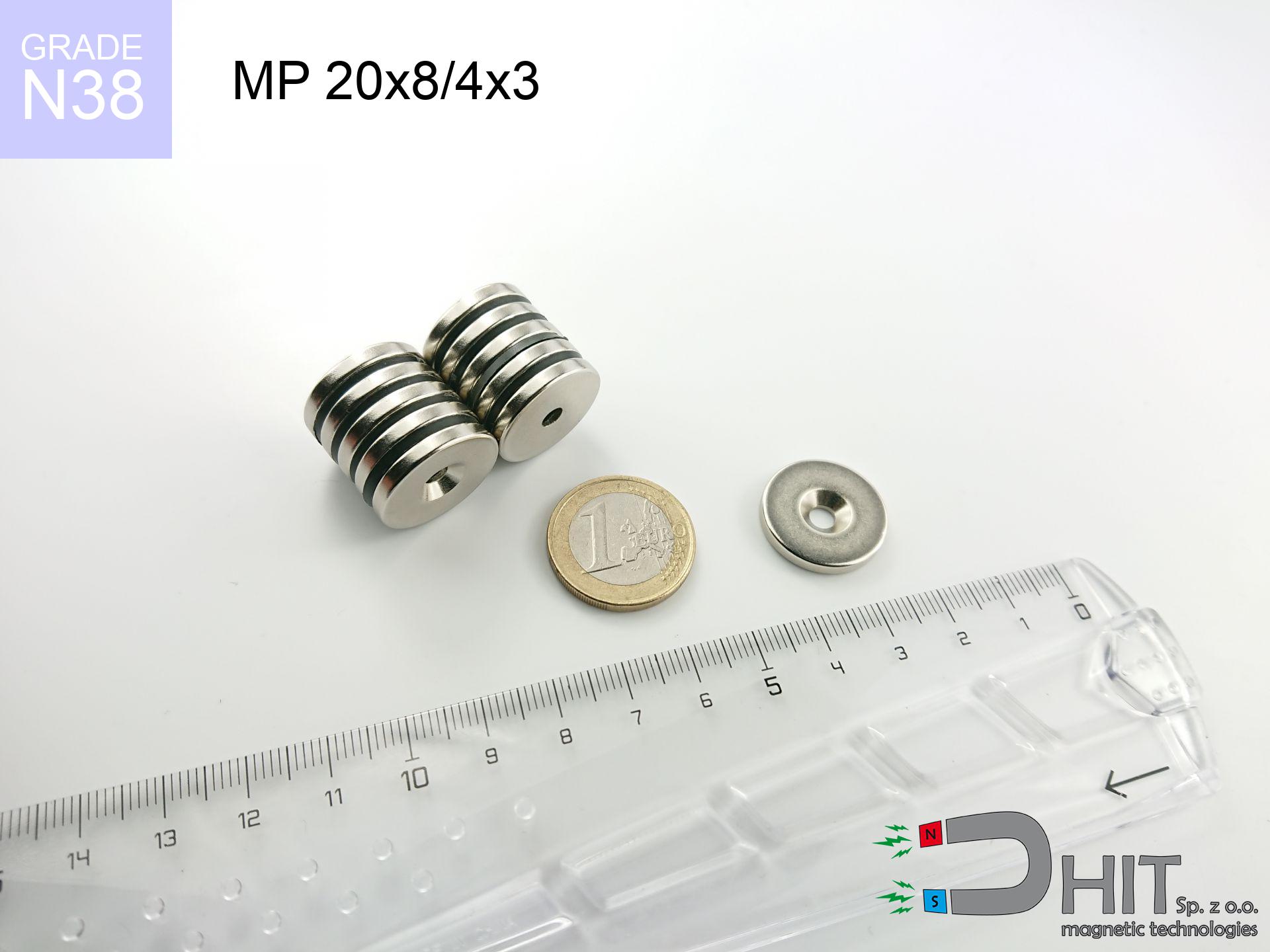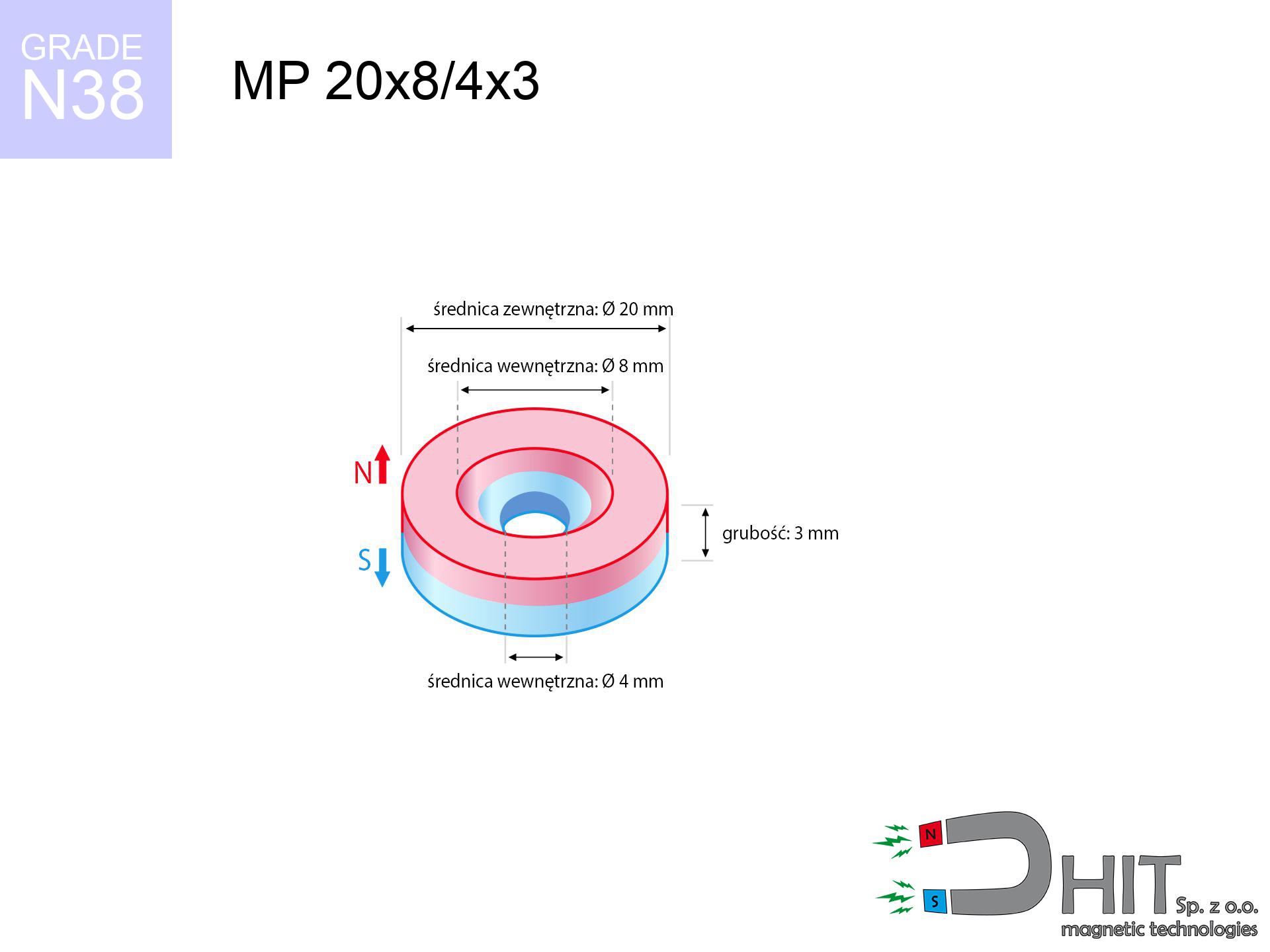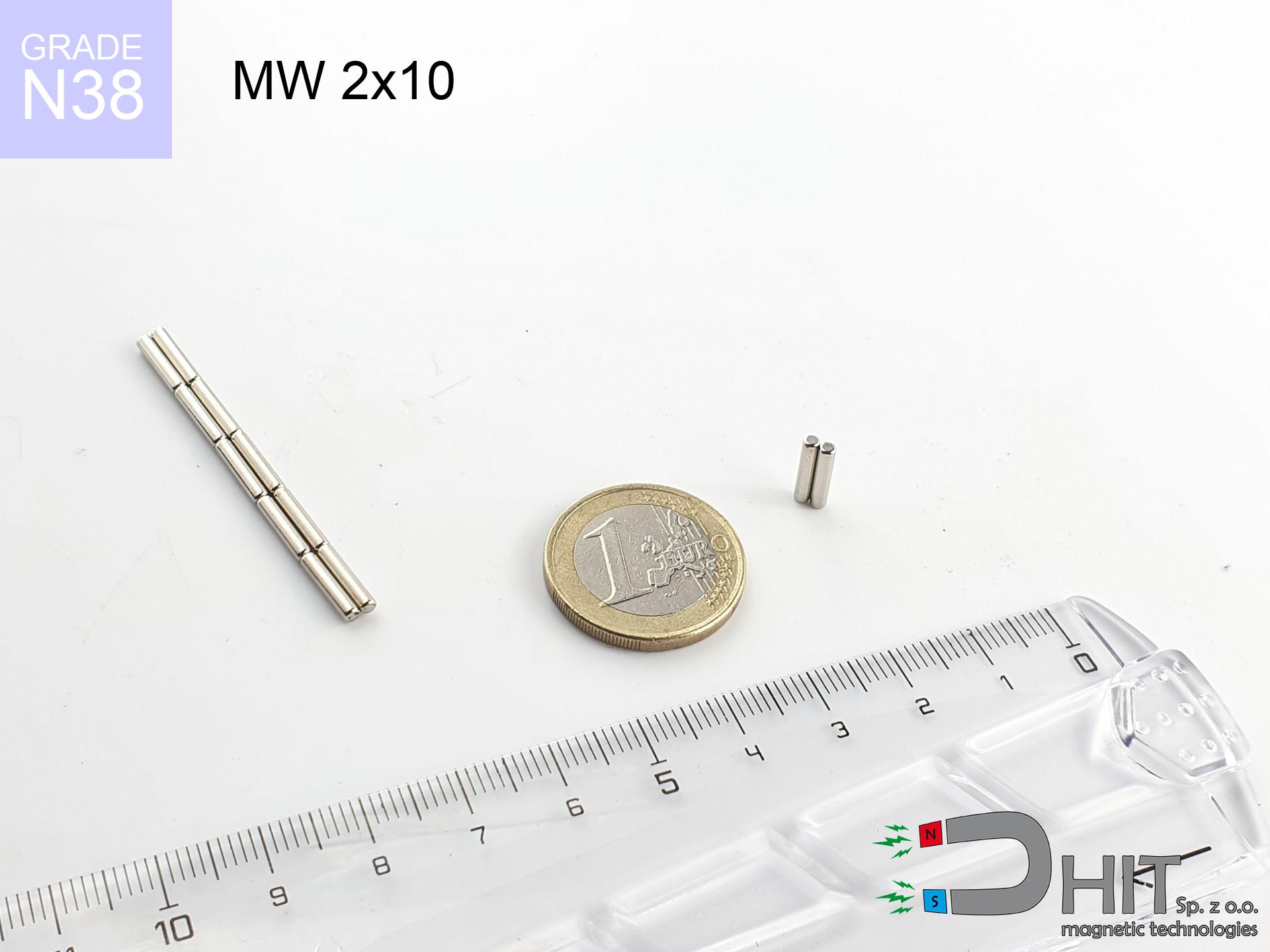MP 20x8/4x3 / N38 - ring magnet
ring magnet
Catalog no 030187
GTIN: 5906301812043
Diameter [±0,1 mm]
20 mm
internal diameter Ø [±0,1 mm]
8/4 mm
Height [±0,1 mm]
3 mm
Weight
9.9 g
Magnetization Direction
↑ axial
Load capacity
1.03 kg / 10.1 N
Magnetic Induction
336.17 mT
Coating
[NiCuNi] nickel
3.59 ZŁ with VAT / pcs + price for transport
2.92 ZŁ net + 23% VAT / pcs
bulk discounts:
Need more?Do you have a hard time selecting?
Contact us by phone
+48 22 499 98 98
alternatively get in touch using
our online form
the contact form page.
Weight as well as appearance of magnets can be estimated on our
force calculator.
Orders submitted before 14:00 will be dispatched today!
Magnetic properties of material N38
Physical properties of sintered neodymium magnets Nd2Fe14B at 20°C
Shopping tips
Pros as well as cons of rare earth magnets.
Apart from their superior power, neodymium magnets have these key benefits:
- Their strength is maintained, and after around ten years it decreases only by ~1% (theoretically),
- They are extremely resistant to demagnetization induced by external magnetic fields,
- In other words, due to the shiny layer of silver, the element gains visual value,
- They show high magnetic induction at the operating surface, which affects their effectiveness,
- Made from properly selected components, these magnets show impressive resistance to high heat, enabling them to function (depending on their shape) at temperatures up to 230°C and above...
- In view of the potential of precise molding and adaptation to custom needs, NdFeB magnets can be modeled in a broad palette of forms and dimensions, which increases their versatility,
- Fundamental importance in modern industrial fields – they are utilized in mass storage devices, drive modules, precision medical tools, also technologically advanced constructions.
- Relatively small size with high pulling force – neodymium magnets offer impressive pulling force in compact dimensions, which makes them useful in compact constructions
Characteristics of disadvantages of neodymium magnets and proposals for their use:
- At very strong impacts they can crack, therefore we advise placing them in special holders. A metal housing provides additional protection against damage and increases the magnet's durability.
- Neodymium magnets lose their force under the influence of heating. As soon as 80°C is exceeded, many of them start losing their power. Therefore, we recommend our special magnets marked [AH], which maintain durability even at temperatures up to 230°C
- Due to the susceptibility of magnets to corrosion in a humid environment, we suggest using waterproof magnets made of rubber, plastic or other material immune to moisture, in case of application outdoors
- Due to limitations in creating nuts and complicated forms in magnets, we recommend using casing - magnetic mechanism.
- Possible danger related to microscopic parts of magnets pose a threat, when accidentally swallowed, which is particularly important in the aspect of protecting the youngest. Additionally, small elements of these products can be problematic in diagnostics medical when they are in the body.
- Due to neodymium price, their price is relatively high,
Highest magnetic holding force – what it depends on?
Magnet power was determined for optimal configuration, taking into account:
- using a base made of mild steel, acting as a ideal flux conductor
- possessing a massiveness of at least 10 mm to ensure full flux closure
- with an polished touching surface
- under conditions of gap-free contact (metal-to-metal)
- under axial force vector (90-degree angle)
- in stable room temperature
Impact of factors on magnetic holding capacity in practice
Real force is affected by working environment parameters, including (from priority):
- Clearance – the presence of any layer (rust, dirt, gap) acts as an insulator, which lowers power steeply (even by 50% at 0.5 mm).
- Load vector – maximum parameter is reached only during perpendicular pulling. The force required to slide of the magnet along the plate is standardly many times smaller (approx. 1/5 of the lifting capacity).
- Element thickness – to utilize 100% power, the steel must be adequately massive. Paper-thin metal limits the lifting capacity (the magnet "punches through" it).
- Steel type – mild steel attracts best. Higher carbon content reduce magnetic properties and lifting capacity.
- Base smoothness – the smoother and more polished the plate, the better the adhesion and stronger the hold. Roughness acts like micro-gaps.
- Operating temperature – NdFeB sinters have a sensitivity to temperature. When it is hot they are weaker, and in frost gain strength (up to a certain limit).
* Lifting capacity was determined using a polished steel plate of suitable thickness (min. 20 mm), under vertically applied force, whereas under shearing force the holding force is lower. Moreover, even a minimal clearance {between} the magnet and the plate decreases the lifting capacity.
H&S for magnets
Risk of cracking
Beware of splinters. Magnets can fracture upon violent connection, ejecting sharp fragments into the air. We recommend safety glasses.
Thermal limits
Keep cool. NdFeB magnets are susceptible to temperature. If you need resistance above 80°C, ask us about HT versions (H, SH, UH).
Pinching danger
Large magnets can break fingers in a fraction of a second. Do not place your hand betwixt two attracting surfaces.
Caution required
Use magnets with awareness. Their powerful strength can shock even professionals. Stay alert and do not underestimate their force.
Machining danger
Combustion risk: Rare earth powder is highly flammable. Avoid machining magnets without safety gear as this risks ignition.
ICD Warning
People with a ICD have to maintain an safe separation from magnets. The magnetic field can stop the functioning of the implant.
Adults only
Only for adults. Tiny parts pose a choking risk, causing intestinal necrosis. Keep away from kids and pets.
GPS and phone interference
GPS units and mobile phones are highly sensitive to magnetic fields. Direct contact with a strong magnet can decalibrate the sensors in your phone.
Electronic hazard
Very strong magnetic fields can corrupt files on payment cards, HDDs, and storage devices. Stay away of at least 10 cm.
Allergic reactions
A percentage of the population experience a hypersensitivity to nickel, which is the common plating for NdFeB magnets. Frequent touching can result in a rash. We recommend use safety gloves.
Warning!
Want to know more? Read our article: Why are neodymium magnets dangerous?




![SM 18x275 [2xM5] / N42 - magnetic separator SM 18x275 [2xM5] / N42 - magnetic separator](https://cdn3.dhit.pl/graphics/products/sm-18x275-2xm5-zep.jpg)


![SM 32x475 [2xM8] / N42 - magnetic separator SM 32x475 [2xM8] / N42 - magnetic separator](https://cdn3.dhit.pl/graphics/products/sm-32x475-2xm8-jot.jpg)

